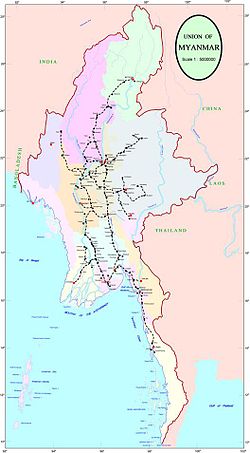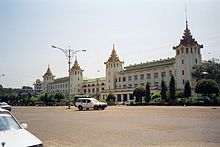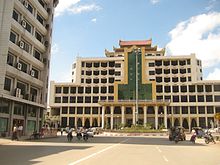- Myanmar Railways
-
Myanmar Railways
မြန်မာ့ မီးရထား
Rail network in 2008Locale Myanmar Dates of operation 1896–present Predecessor Irrawaddy Valley State Railway, Sittang Valley State Railway, Mu Valley State Railway Track gauge 1,000 mm (3 ft 3 3⁄8 in), Metre gauge Length 5,403 km (3,357 mi) (2010) Headquarters Yangon Website http://www.myanmarailways.com - This article discusses Myanmar Railways, originally known as Burma Railways. For the article on the World War II railway between Thailand and Burma, see Burma Railway.
Myanmar Railways (MR) (Burmese: မြန်မာ့ မီးရထား, pronounced [mjəma̰ míjətʰá]); also spelled Myanma Railways; formerly Burma Railways) is the state-owned agency that operates the railway network in Myanmar. The 5,403-kilometre (3,357 mi) metre gauge rail network consists of 858 stations,[1] and generally spans north to south with branch lines to east and west. MR also operates the Yangon Circular Railway line, Yangon's commuter rail network. MR operates 18 freight trains, and 379 passenger trains, transporting over 100,000 passengers daily.[2]
The quality of the railroads is generally poor. Most remain in poor repair and are not passable during the monsoon season. The speeds of freight trains are heavily restricted on all existing links as a consequence of poor track and bridge conditions. The maximum speed for freight trains has been quoted as 24 km/h (15 mph), suggesting that commercial speeds on this section could be as low as 12–14 km/h (7.5–8.7 mph).[3]
MR has steadily increased the reach of its network in the last two decades, from nearly 3200 km in 1988 to 5403 km in 2010. MR is currently undertaking an ambitious expansion program that will add another 3,645 km (2,265 mi) to its network, including extensions to Myeik in the south, Kyaingtong in the east, Sittwe in the west.[4]
Contents
History
Main article: History of rail transport in BurmaRail transport was first introduced in Myanmar in May 1877 when Lower Burma was a British colony with the opening of the 163-mile (262 km) Yangon to Pyay line by The Irrawaddy Valley State Railway. In 1884, a new company, The Sittang Valley State Railway, opened a 166-mile (267 km) line along the Sittaung River from Yangon to the town of Taungoo via Bago. After the annexation of Upper Burma following the Third Anglo-Burmese War of 1885, the British extended the Taungoo line to Mandalay, the fallen capital, by 1889. Following the opening of this section, the Mu Valley State Railway was formed and construction began on a railway line from Sagaing to Myitkyina and connected Mandalay to Shwebo in 1891, to Wuntho in 1893,[5] to Katha in 1895, and to Myitkyina in 1898.
In 1896, before the completion of the line to Myitkyina, the three companies were combined into the Burma Railway Company as a state owned public undertaking.[6] The railway was known as Burma Railways between 1928 and 1989. The railway's reach to the Taninthayi coast first came in 1907 with the opening of the Bago-Mottama line. Passengers had to take a ferry over the Thanlwin River (Salween River) to Mawlamyaing. In 1942, the country had 3,313 km (2,059 mi) (route-km) of metre gauge track, but during World War II the Japanese removed about 480 km (298 mi). By the end of the conflict only 1,085 km (674 mi) (route-km) was operational, in four isolated sections.[7] They constructed the only international link the country has enjoyed, from Thanbyusayat Junction via Three Pagodas Pass to Thailand, the short-lived Death Railway.
After Myanmar gained independence from the UK in 1948, the rail network was rebuilt. By 1961 the network extended to 3,020 km (1,877 mi), and then remained constant until the opening of a 36 km (22 mi) line from Kyaukpadaung to Kyini in October 1970. In 1988, MR operated 487 railway stations over a 3,162 km (1,965 mi) long network. Since coming to power in 1988, the current military government has embarked on a railroad construction program, and by 2000 MR operated 5,068 km (3,149 mi) (track-km) divided into 11 operating divisions. Most of the routes are single track although large parts of Yangon-Pyay and Yangon-Mandalay routes are double track.[7]
Recent railroad expansion
1994 saw the start of construction of the initially isolated 160 km (99 mi) Ye-Dawei (Tavoy) railway, completed March 1998. This was later joined to the route north at Ye by the new 250 m (270 yd) road/rail bridge across the Ye River, opened November 2003. In April 2008, the tracks were extended across the 2.4 km (1.5 mi) Moulmein road/rail bridge, provision having been made in its design when it was opened a few years earlier. This allowed the long isolated section south to Ye and later Dawei (Tavoy) to receive trains from the north of the country. Also in 2008/9, the Ayeyawady Valley route was extended north along the west bank of the river towards Pakokku in the far north of the country. The 60 km (37 mi) Kyangin-Okshippin (Padang) section of Kyangin-Thayet railway was opened in March 2008 and the 56 km (35 mi) Okshippin-Kamma railway section was opened in March 2009.
In 2009, planning started on a link from Lashio to Jiegao in China. This links would have a 1,000 mm (3 ft 3 3⁄8 in) - 1,435 mm (4 ft 8 1⁄2 in) break-of-gauge.
In 2010, MR is working on multiple railroad construction projects: Motagyi-Bhamo (130 km/81 mi), Mongnai-Kyaingtong (346 km/215 mi), Minbu-An-Yechanpyin (395 km/245 mi), Dawei-Myeik (213 km/132 mi), Pathein-Nyaungdon-Yangon Hlaingthaya (143 km/89 mi), Pyay-Taungoo-Naypyidaw (193 km/120 mi), Hinthada-Nyaungdon (77 km/48 mi), Thayet-Kyunchaung (307 km/191 mi), Ywataw-Kanpya (105 km/65 mi).[1]
Rail network and services
MR operates 858 stations throughout the country. Yangon Central and Mandalay Central have been the twin anchors of the network. Recently, MR has extended rail service along the Taninthayi coast to Mon State and Tanintharyi Region with Mawlamyaing Station as the southern hub. The network generally runs north to south with branches to east and west.
Lower Myanmar
Line Route Notes Yangon-Mandalay Yangon-Bago-Naypyidaw-Thazi-Mandalay Express trains skip Bago Yangon-Mawlamyaing Yangon-Bago-Theinzayat-Kyaikhto-Thaton-Mottama-Mawlamyaing Yangon-Bagan Yangon-Taungoo-Leway-Taungdwingyi-Kyaukpadaung-Bagan Yangon-Aunglan-Bagan Yangon-Letbadan-Paungde-Aunglan-Kyaukpadaung-Bagan Yangon-Pyay Yangon-Pyay Mawlamyaing-Dawei Mawlamyaing-Ye-Dawei Upper Myanmar
Line Route Notes Mandalay-Myitkyina Mandalay-Sagaing-Shwebo-Myitkyina Mandalay-Lashio Mandalay-Pyinoolwin-Kyaukme-Thibaw-Lashio Mandalay-Thazi Mandalay-Thedaw-Dahuttaw-Hanza-Ywapale-Thazi Monywa-Pakkoku Monywa-Khinnu-Mandalay-Pakkoku Yangon Circular Railway
Main article: Yangon Circular RailwayMR also operates a 45.9-kilometre (28.5 mi) 39-station loop system that connects Yangon's downtown, satellite towns and suburban areas. The railway runs 200 times and sells 150,000 tickets daily.[3][8] The loop, which takes about three hours to complete, is a way to see a cross section of life in Yangon for common people.
Fleet
In early 2011, MR operated 389 locomotives and 4673 railway coaches.[9]
Locomotives
In 1999 MR had 201 diesel locomotives, and a further 88 were on order. Up to 1987 the main suppliers were Alsthom, Krupp and various Japanese companies, but since then orders have been placed with China owing to Myanmar's lack of access to hard currency. In 2004, MR had approximately 40 oil-fired steam locomotives, of which about a dozen were serviceable and saw occasional use on goods, local passenger and tourist trains. Up to three heavy repairs are performed per year using locally-manufactured parts.[7] Between 1988 and 2009, MR imported 96 diesel locomotives, 55 from China and 41 from India.[2] In December 2009, MR had a total of 319 locomotives. In October 2010, MR acquired 30 more locomotives from China.[4]
Coaches
In 1999 MR had 868 coaches, with a further 463 on order. However many branch lines have only lightly built permanent way, and on these routes traffic is in the hands of a fleet of more than 50 light rail-buses built from lorry parts in MR's workshops. These are powered through their rubber-tired road wheels, and usually haul three small four-wheel coaches converted from goods wagons. Small turntables are used to turn the rail-buses at the termini.[7]
Wagons
There were 5187 freight wagons in 1999, with 1188 due to be delivered. The majority of goods trains on lines without significant gradients run without any train brakes, as most of the serviceable wagons have been cannibalized and now lack vacuum hoses. Goods trains up to 600 tonnes are braked by the locomotive only, and operate at a maximum speed of 32 km/h. If the train is particularly heavy the wagons at the front will be fitted with hoses for the duration of the trip. On the steeply-graded ghat sections all wagons will be braked.[7]
Maps
References
- ^ a b "MR to link Mandalay and Bhamo". New Light of Myanmar. 2010-02-22.
- ^ a b "Myanmar imports more locomotives to help facilitate rail transportation". Xinhua News. 2009-01-20. http://news.xinhuanet.com/english/2009-01/20/content_10688991.htm.
- ^ a b Yeni (2008-01-30). "The Railway Bazaar". The Irrawaddy. http://www.irrawaddy.org/multimedia.php?art_id=10074.
- ^ a b "30 Locomotives Transferred from China" (in Burmese). Bi-Weekly Eleven 3 (30): 7. 2010-10-15.
- ^ Dautremer, Joseph (1913) Burma under British Rule (translated from Dautremer, Joseph (1912) La Birmanie sous le régime britannique: une colonie modèle Guilmoto, Paris, OCLC 250415892) T.F. Unwin, London, page 205, OCLC 9493684; full text pp. 194-213 from the online library eBooksRead.com
- ^ Ireland, Alleyne (1907). "The Province of Burma: A report prepared for the University of Chicago". Boston and New York: Houghton Mifflin and Company.
- ^ a b c d e Dieter Hettler (2004-11-01). Update from Myanmar. Railway Gazette International. http://www.railwaygazette.com/news/single-view/view//update-from-myanmar.html.
- ^ Third Regional EST Forum: Presentation of Myanmar. Singapore: Ministry of Transport, Myanmar. 17–19 March 2008. http://www.uncrd.or.jp/env/3rd-regional-est-forum/doc/23_Myanmar.pdf.
- ^ "Number of autos, motorcycles increases in Myanmar". Bi-Weekly Eleven News. 2011-01-26. http://eversion.news-eleven.com/index.php?option=com_content&view=article&id=1077:number-of-autos-motorcycles-increase-in-myanmar&catid=43:biweekly-eleven-eversion&Itemid=110.
External links
- Ministry of Rail Transportation (Burmese) http://www.ministryofrailtransportation.com
- Myanmar Railways in Ministry of Rail Transportation (Burmese) http://www.ministryofrailtransportation.com/myanma_railways.html
- Myanmar Railways Web site in English http://www.myanmarailways.com/
- Myanmar Railway Schedule http://www.yangonow.com/eng/transportation/train/schedule.html
- Myanmar Railway Fares http://www.yangonow.com/eng/transportation/train/fare.html
- Information about the construction of Ye - Dawei railway line- http://www.myanmar.gov.mm/Perspective/persp1998/3-98/con3-98.htm
- Inauguration Ceremony for the construction of Dawei- Myeik railroad by Myanmar TV 3 - http://www.mrtv3.net.mm/open5/061208tran.html
- New Construction Projects of Myanmar Railway - http://www.mrtv3.net.mm/open5/051208tran.html
- The inauguration for the construction of Katha - Bhamo railroad - http://www.mrtv3.net.mm/open4/010108tran.html
- Information about Kyangin-Pakokku railroad project - http://www.myanmar-information.net/infosheet/2006/070129.htm
- Map, Schedules and Fares of Myanmar Railway -http://www.freewebs.com/myanmar2005/transport.htm
- The New Light of Maynmar - 4 April 2009 - http://myanmargeneva.org/NLM2009/eng/4Apr/n090404.pdf
- Opening of Moulmein Bridge -16/4/08 - http://www.myanmar-information.net/infosheet/2006/060419.htm
Categories:- Rail transport in Burma
Wikimedia Foundation. 2010.


